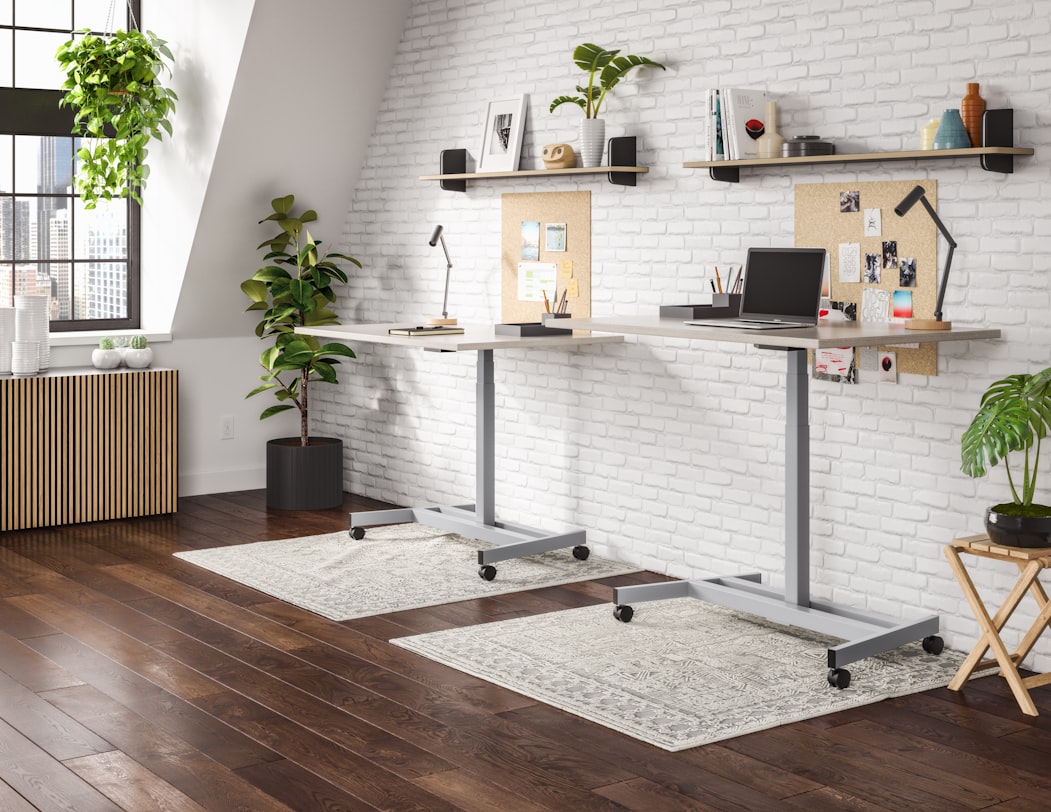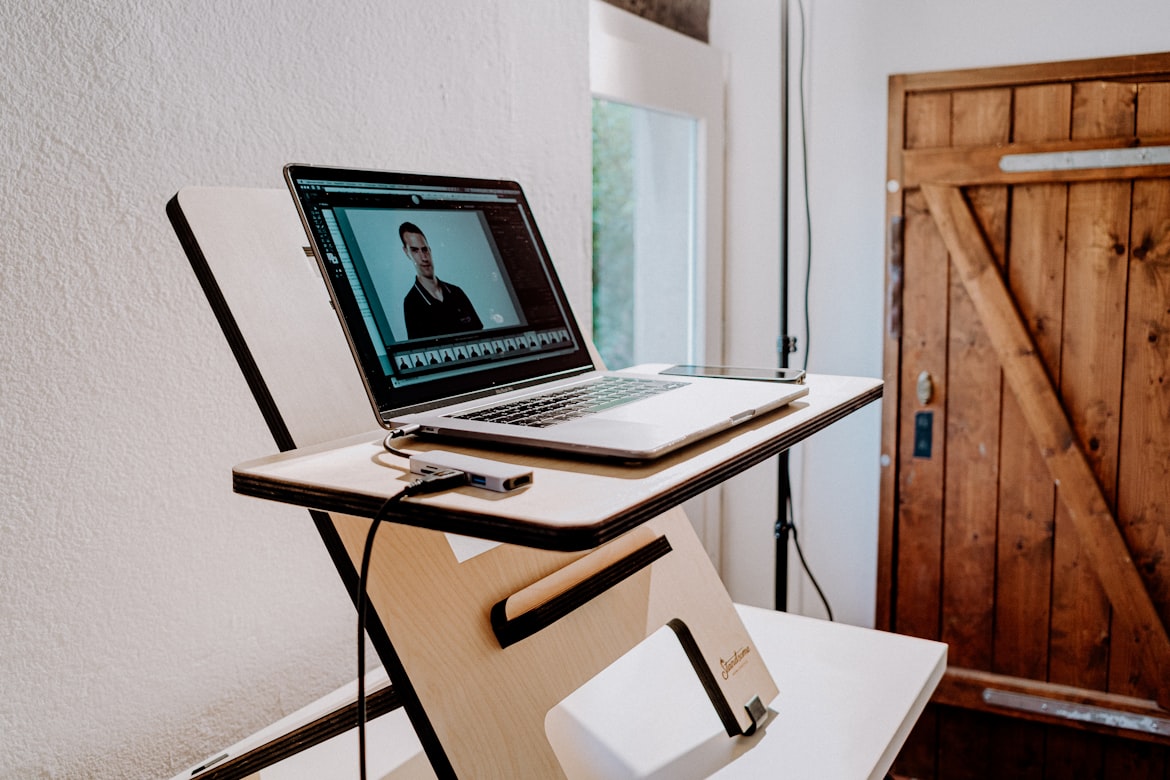Let’s talk about desk height vs table height. I know, I know. It doesn’t sound like the most “interesting” topic around, but hear me out: it’s actually really important to get your desk (and table) height just right.
Whether you’re working from home like me, out of your home office, spending your days in a cubicle, or sitting down for a homemade dinner with the family, chances are, you spend a lot of time sitting down at these spaces. Unfortunately, if the chairs you’re sitting in aren’t sized correctly, you have a pretty good chance of running into back pain and issues over time.

Most people are different heights, making the idea of a standard surface height somewhat moot. Sure, you can address the issue by using ergonomic chairs, but the height of the surface you’re working with still makes a huge difference.
Today, I’ll be going over everything you need to know when it comes to desks, standard table sizes, and avoiding those dreaded lower back pain problems. It’s important guys. Let’s go!
Desk Height Considerations

Before I tell you how to get the proper height for your desk space or work surface, let’s figure out what the standard desk height is. As it turns out, most desks are designed with a six-foot-tall user in mind.
If you happen to be this height then it’s smooth sailing from here on out! However, considering most people aren’t 6” tall, the standard sitting desk height of 29” isn’t exactly ideal. Of course, sitting desks aren’t the only options you have these days, so let’s quickly compare the options!
The Ideal Desk Height vs Table Height for the Average Person

If you want to get more specific in the comparison of desk height vs table height, it’s helpful to be a bit more precise than simply using inches. Above, I said 29” was a fairly standard height, but a range of 73 to 80 centimeters would be a bit more precise.
This does give you a little bit of wiggle room to work with, but even so, the height of the desk is generally still chosen with a fairly tall user in mind. With roughly 14.5% of men in the United States standing six feet tall, it’s fairly obvious that this isn’t a one-size-fits-all situation!

Fortunately, adjustable desks are becoming more common. These desks are better suited for office ergonomics as they can be matched to the height of the user. This is especially important for limiting back & neck pain!
If possible, I recommend both individuals and businesses invest in adjustable models. Having one can be especially important if multiple people use the same desk. With a fixed-height desk, half the people will find it too high; the other half will likely find it too low.
You won’t run into these issues if you can adjust the height to match the current user as needed!
Standing Desks

When it comes to standing desks, there isn’t really an average desk height. However, it’s fairly common to see desks ranging from 44 to 47 inches in height. 44” should be great for you if you’re 5’11”, but if you’re shorter—or taller—then this height likely won’t be ideal for an all-day standing position.
Fortunately, you can overcome this issue by picking up an adjustable standing desk. The adjustable models can get a bit more pricey than their fixed-height alternatives, but I think the trade-off is worth it.
Sure, you might need to pay a little bit more upfront now, but that’s much better than paying for repeated trips to the chiropractor later on down the road!
Ergonomics to Consider for Desk Height vs Table Height

Alright, so there’s a specific point where desk height vs table height intersects: ergonomics! The best way to maximize comfort and minimize potential injury is by ensuring the height of your desk (or table) is at the correct height at all times.
Ideally, when sitting in your office chair, you’ll want your feet placed flat on the ground. Your hips should be slightly higher than your knees, and your back should be resting against the back of your seat: no slouching!
This should put the angle between your legs and your back between 90 and 100 degrees.

Elbow height is also important when trying to achieve the correct desk height and posture. Your elbows should be at about the same level as your desk surface, with your forearm extending at a 90-degree angle out from your body.
Use your arms rests to support this right angle, and make sure your wrists are straight while typing on your keyboard tray. This will help prevent shoulder pain.
Lastly, the top of your computer monitor should be roughly equal to your eye level. This placement eliminates the need to bend your neck while working, helping prevent neck pain from a long day in the office!
Tables

No desk height vs table height article would be complete without addressing tables, so let’s move away from desks for a bit. Of course, there are many different types of tables, and some tables—like a coffee table—will surely be smaller than larger pieces like a wood dining table.
Although you can apply the same principles to your living room decor, today, we’ll be focusing specifically on dining tables! When it comes to standard table heights, a height of 28 to 30 inches—or 71 to 76 centimeters —-is common. Of course, kitchen table dimensions vary as well!
When it comes to standard chair heights, you’ll generally find dining room chair heights ranging from 18 to 20 inches, or 45 to 51 centimeters tall.
Fixed Heights

As from the standard dining table height, there are a few other sizes you should become familiar with. If you’re looking for slightly taller tables for your dining room then you’ll be moving up to counter height tables.
Counter height tables are generally 34 to 36 inches—86 to 91 centimeters—tall, with seats standing 24 to 26 inches—61 to 66 centimeters—tall.
Lastly, bar height tables tower above either option. Bar-height tables will generally stand between 40 to 42 inches—101 to 106 centimeters—tall, with bar stools standing 28 to 30 inches—71 to 76 centimeters—tall.
After you find the perfect table for your home, check out my post on styling your table!
The Benefits of Adjustable Height Seats

You’ve probably realized something while reading this desk height vs table height piece: there are way more adjustable height options for desks than there are for tables!
Well, when it comes to tables, people tend to focus less on ergonomics and more on looks. This is because we generally don’t spend as much time at the dining table as we would at our desks, making achieving the best height for every person seem slightly less important.
Still, I think it’s worth at least considering adding height-adjustable seating to your dining area. After all, your guests aren’t all the same height! Opting for adjustable seating might end up limiting your options a bit, but the overall comfort factor is a giant improvement.

Still, the final choice is up to you when it comes to your dining area. Perhaps you won’t be able to find an adjustable chair that matches your aesthetic, or maybe you just don’t mind the current seating you have. That’s perfectly okay!
While I won’t tell you what to do with your space, I will strongly encourage you to at least consider upgrading your workspace. For starters, adding some wall art or a few aromatherapy candles can help spruce up the place a bit.
That said, implementing adjustable seating for your workspace will do wonders, both for your daily comfort as well as your overall mental health.
Let’s be honest: who really wants to deal with back pain on the daily!?
Considering Desk Height vs Table Height

As we’ve seen, there are many differences when it comes to desk height vs table height. However, one thing remains the same for both seating options: a person who’s average height likely isn’t enjoying an optimal seating experience!
For short, average, and even tall people, finding the right height for a surface can be a challenge. Still, if there’s anything you take away from this article, I hope it’s the value of an adjustable seat!
Back pain, neck pain, and shoulder pain shouldn’t be preventing you from enjoying life to the fullest. While simply changing the desk/table set up in your modern interior decor might not completely solve all of your problems, it’s sure to make a big difference!
So, did you learn anything new from this post? Perhaps you already knew the value of ergonomics, but simply wanted to see if you could learn anything new? Either way, I’d love to hear about it!
Leave me a message in the comment section below guys. I love to hear from y’all. Until next time!
Commonly Asked Questions about Desk Height vs Table Height

What height should a standing desk be for 5’ 11”?
Well, it’s hard to figure out the perfect height for your desk based on height alone, but for a person who’s 5’11”, a standing desk that’s 42” tall should be about right. Of course, feel free to adjust this slightly as needed depending on your particular use case!
How do you adjust the height of an adjustable desk?
Adjusting your desk is important if you want to get the ideal desk height for comfort and ergonomics. Fortunately, it’s not very hard to do: you just need to figure out if your adjustable desk is manual or electric!
If it’s electric, simply use the adjustment buttons to reach your desired height. If the option is there, I suggest using the memory button to save your height settings. This is often labeled as “M”.
Manual desk adjustments are generally done with either a winding handle or pressure paddles. For handles, simply turn the handle until you’ve reached the perfect height. For paddles, you’ll need to push the paddles in to release the desk from its set position. Adjust as needed, then give it a small downward push until you hear the desk “click” into place.
Are desks taller than dining tables?

Generally speaking, desks and standard dining tables tend to be around the same height. However, unlike dining tables, desks often have the advantage of being adjustable, making them better suited to tasks like using a computer, writing, or reading a book. Speaking of which, here’s one of my favorite reads!
Is it better to have your desk higher or lower?
It’s a good idea to have your desk adjusted to your height. However, from there, you may need to tweak it a bit more for maximum efficiency. Generally, having your desk slightly higher is better for handwriting. On the other hand, people typing may prefer a slightly lower desk instead.
Are standing desks good for you?
Options are quite split on this topic, so I’ll stick strictly to facts. Sitting all day isn’t good for your health. Neither is standing all day. Add in having bad posture, and your computer desk is quickly becoming a health hazard! In the end, movement is best for your body, so regardless of if you’re using a sitting desk or a standing desk, you should try to move around every 30 minutes or so.













